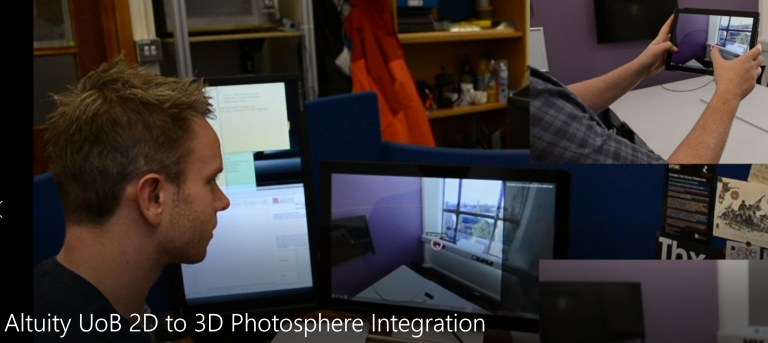Altuity and the University of Bristol Democratizing BIM Project
In this latest post we describe progress at the 3 month stage of our R&D project with the University of Bristol. This research project, which is co-funded by the UK Government Innovation Agency (Innovate UK), aims to democratise access to BIM within operations and maintenance by using 3D photospheres and augmented reality.
Achieving this will provide the education sector (schools, MATs etc.) and the commercial sector with access to pragmatic, affordable and leading edge 3D technology to help maintain buildings, estates and assets which up until now has been unaffordable and/or required specialist skills.
Watch this short video (just over a minute long) to see the concepts explained below in action. It shows how you can:
- capture 360º photospheres
- calibrate the photospheres to floor plans within a browser (no CAD required)
- mark up features of interest in the photosphere e.g. record a defect
- access information in the office or on-site via augmented reality (AR)
After 6 months work we’re approaching the point where we’ll be making the software available to a limited number of early adopters for evaluation and feedback.
Capturing 3D Photospheres for FM
Capturing a 3D photosphere is simple and cost effective which is why we’ve chosen to use this technology. However given that they’ll be used for asset and maintenance management purposes there’s a need for a best practice guide which we’ve now written. For example, there are two key areas to consider to get the most from the photospheres:
1. Distance and angle of the camera to the assets
Distance and camera angle are important considerations given the different sizes of assets that might need to be marked up in a photosphere. For example, there’s an optimum distance to visually recognise a fire alarm compared to a larger asset or feature such as a door or window.
Our testing showed that the optimal distance from asset to camera should be approximately 3m with an angle of 40º.
2. Room size and shape
The room size and shape determine how many photospheres are needed to get the required visual coverage of the space. A small rectangular or square shaped room will require fewer photospheres than a larger space such as a hall, gym or ‘L’ shaped space. With multiple photospheres in use they need to be linked together to facilitate virtual room walking as well as being able to virtually walk an entire building.
Calibrating Photospheres to 2D Floor Plans
While viewing and managing data related to assets or facilities requests in the photosphere is very beneficial it does not entirely replace the need for a 2D view in order to see it on, for example, a floor plan. Calibration is therefore required to integrate 3D photospheres to 2D floor plans.
The calibration process involves identifying the camera position on the 2D plan and then matching room features with the plan such as the room corners. Once the calibration has been completed markers can be positioned on the 2D plan and they appear in the right location in the 3D photosphere or alternatively added to the photosphere and then they’ll appear on the 2D plan.
The calibration process has been built into the software to make it quick and easy so that users can undertake this process themselves. Once calibrated data can be managed from both the floor plan and photosphere environments.
Delivering a Reliable Augmented Reality Experience
A reliable AR experience (AR) is essential in an operational environment. Although AR technology is advancing at a rapid pace we looked at what was required from the user perspective rather than purely from a technological one.
This led us towards adopting a meta-AR approach. This involves using the photospheres on a mobile device with the photospheres automatically aligning themselves. We are then able to reliably overlay data onto the photosphere on-site rather than augmenting it via the camera view. The synchronisation of the photosphere and device is so good that it is often indistinguishable from the camera view.
3D Photospheres, Stakeholders and Income Generation
During our discussions with business managers and facilities teams they’ve identified that as well as using the photospheres for operational asset and maintenance purposes they’re much better than photographs in providing stakeholders with an interactive visual perspective of a room or space. Typical uses would be:
At school governor meetings to better visualise and provide a virtual experience of the condition of school buildings needing refurbishment or replacing;
To show new or refurbished facilities to help promote a school to prospective parents;
To promote a school’s facilities for use by external organisations to help generate income.
They’ll be another final(!) update on the completion of the project in a couple of months’ time. At this point this functionality will be available in AltoSites.

